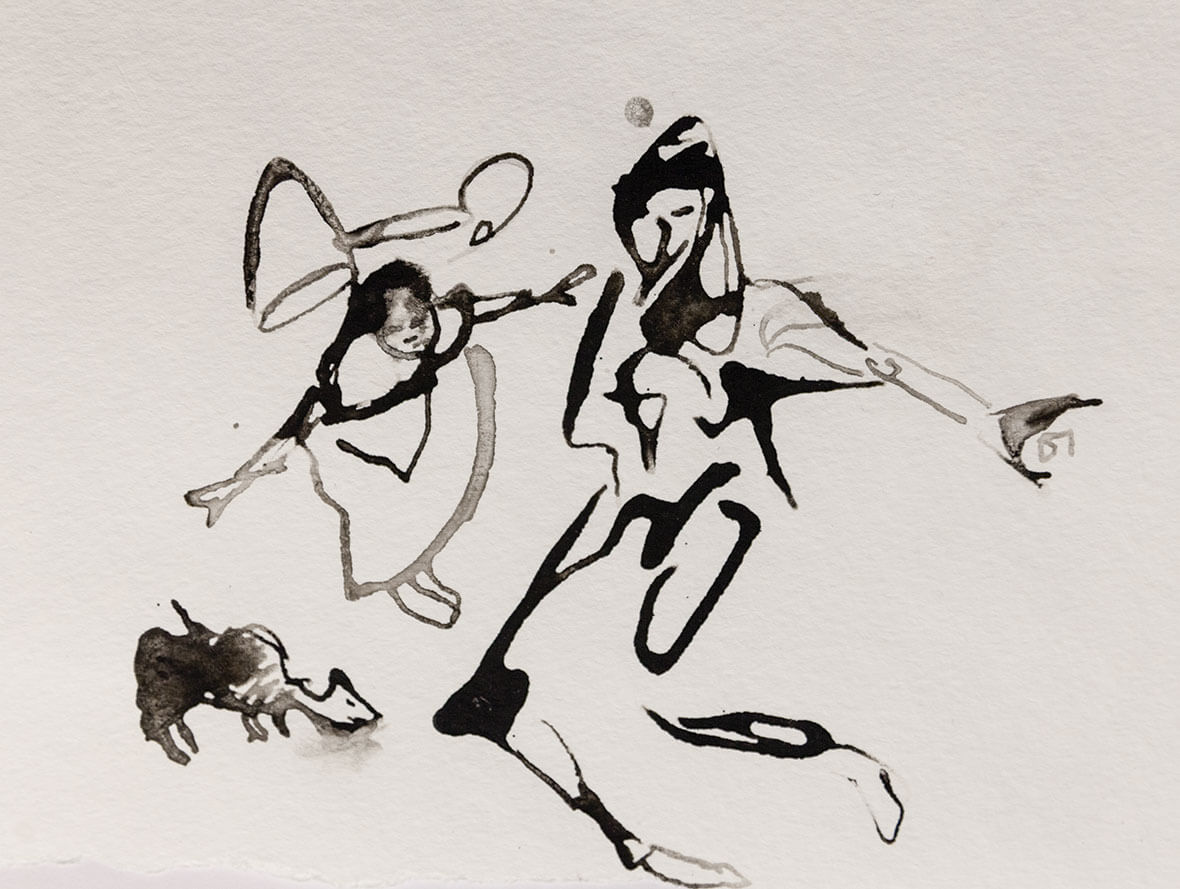Above: Detail from Rachel Rafael Neis. Mixed Species Dancing, 2014. Pen and ink on paper. 5.5 in. x 7.5 in. Courtesy of the artist.
DANCE
For centuries, rabbis have forbidden Jewish men and women from dancing together, often in colorful terms. The fact that these prohibitions had to be frequently repeated suggests that Jews defied communal laws. They also found ways around them, such as by dancing with a separating handkerchief. Prior to the era of Emancipation, Jewish authorities were primarily concerned with the potential for sexual transgression within the Jewish community. In sixteenth-century Greece, Rabbi Binyamin Ze’ev ben Matityahu recom-mended excommunication for married couples who switched partners while dancing, expressing concern that men might fondle married women. Yet by the late eighteenth century in western Europe (and later further east), mixed-sex dancing was frequently identified with values from outside the Jewish commu-nity, and, in short, with the changes wrought by modernity. Rabbis used the language of citizenship when they sought out the help of governmental authorities to prevent Jews from engaging in mixed-sex dancing with Christians, claiming that the kind of person who violated religious precepts would also be inclined to break secular laws. Indeed, Hungarian Reform rabbi and historian Leopold Löw (1811–1875) claimed that the first real opposition to Jewish communal authorities in Germany did not occur in the synagogue, but instead in the dance hall.

Rachel Rafael Neis. Mixed Species Dancing, 2014. Pen and ink on paper. 5.5 in. x 7.5 in. Courtesy of the artist.
German Orthodox rabbi Marcus Lehmann (1831–1890) depicts these issues in his serialized 1868 novella Elvire. Set against the backdrop of the 1848 revolutions, Elvire provides a strong moral message—and enough transgressive dancing to keep readers interested. Lehmann even stages a debate about dancing between the rabbi narrator and his friend, Adolph Metz, a Jewish banker. Adolph has received an invitation to a noble ball, which he views as an opportunity to successfully integrate into German society. Although he points out that dancing is a sign of joy in Jewish culture, his rabbi warns him that the book of Esther shows the dangers of Jews attending non-Jewish court functions. Against his rabbi’s advice, Adolph brings his daughter Elvire to the ball. The results are disastrous, since she becomes reacquainted with a morally dubious Christian suitor.
Dancing was an important social accomplishment for upwardly mobile and politically radical Jews alike during the long nineteenth century, including salonnière Fanny von Arnstein, writer Arthur Schnitzler, journalist Abraham Cahan, and anarchist Emma Goldman. Like military service and athletics, dancing demonstrated that Jews could properly discipline their bodies—yet in a way that challenged the traditional separation of the sexes. Social dance was a courtship activity that invited dancers to evaluate the stamina, grace, and physical connection they felt with their dancing partners. Young people could dance and flirt with individuals whom their parents might deem inappropriate marriage partners––and form relation-ships based on attraction or mutual interests, instead of shared communal values. As a result, writers of literary fiction and religious authorities treated mixed-sex dancing as a symbol of the social changes that trans-formed European Jewry in the modern era. Mixed-sex dancing was a way for writers to discuss the different challenges acculturation presented for Jewish men and women, while simultaneously entertaining their readers.
.tmb-medium.jpg?sfvrsn=66349606_1)
Photo by Adam Berry
SONIA GOLLANCE is a visiting assistant professor in Germanic Languages and Literatures at The Ohio State University, where she directs the Yiddish and Ashkenazic Studies Program. She is writing a book about the taboo of Jewish mixed-sex dancing.